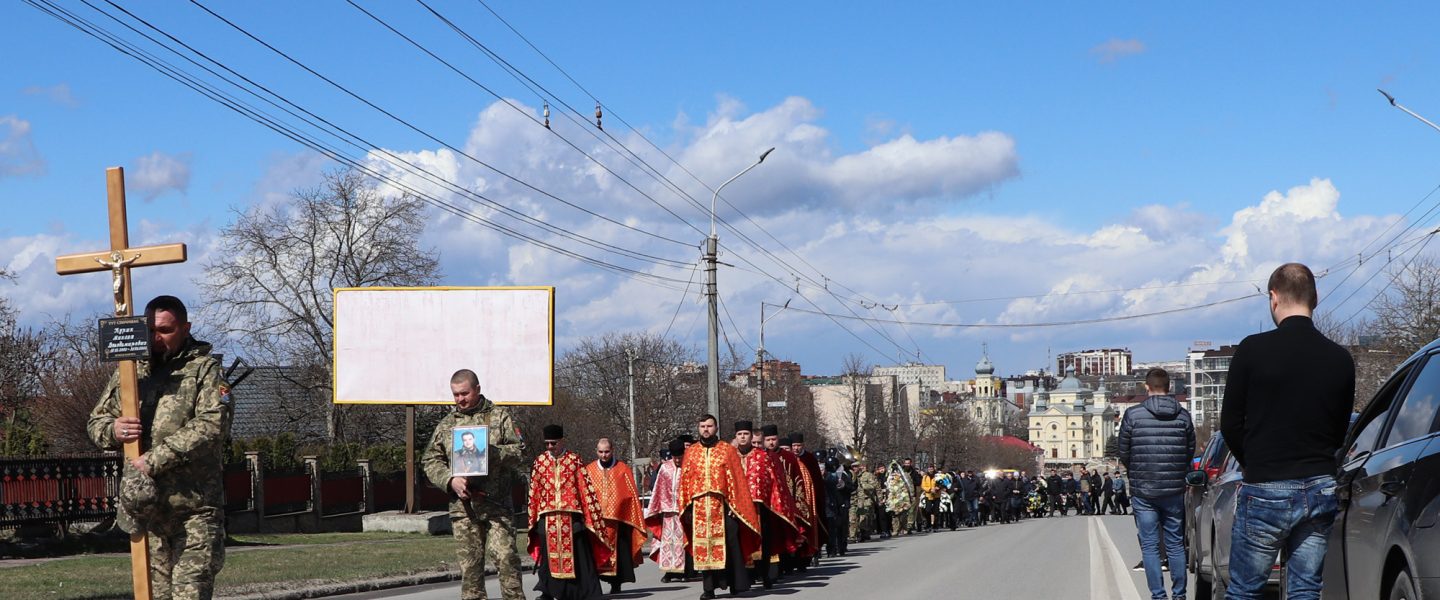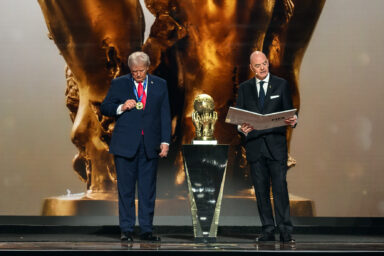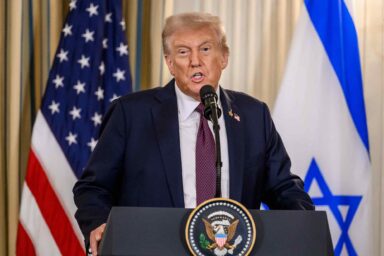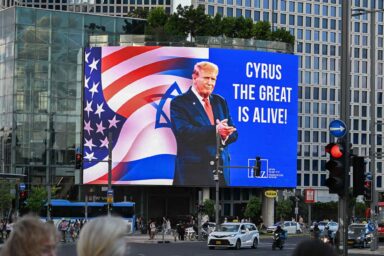Nearly a decade of war and a new hero cult that’s arisen since Russia’s invasion mean Ukraine is now one of the world’s most heavily militarized societies.
TERNOPIL, UKRAINE — Traffic halts at the sight of a Ukrainian soldier holding a wooden cross. Drivers and passengers step out of their cars to pay their respects. Following behind the soldier is a contingent of armed servicemen carrying a coffin.
A pedestrian kneels on the sidewalk as the column of troops turns to enter a graveyard where four more soldiers stand guard at an open grave. More than 200 civilians follow behind. Among them, dressed all in black, is the mother of 19-year-old Mykola Kuryk, whose body lies in the coffin, killed in battle at the end of March near Kyiv.
“He was ready to go places where no one else dared to go,” said the leader of Kuryk’s unit, the volunteer battalion of the Sonechko UPA Special Forces. “Even people with more experience. He did not know fear.”
Kuryk died on a special mission near the frontlines. Noting this, the Orthodox priest giving the final blessing observed, “There is no bigger love than to give your soul to your friends.”
His commander hands two medals to Kuryk’s father, honors for his son’s service. The coffin is lowered into the dark grave as the four soldiers standing guard fire a final salute. The smoke from the rifles vanishes into the blue sky as the coffin disappears below the earth.
Kuryk’s grave is next to several other newly filled ones. Much older graves, belonging to locals killed during World War II — the Great Patriotic War for Soviet veterans — are nearby. But there is room for many more.
Kuryk’s life and his service were both short; but since his death, he has become a flash cult hero in Ternopil. His picture hangs on billboards around the city, offering a promise that martyrs like him — who volunteered to defend his country after the Russian invasion in February — will never be forgotten. He may not be, but he will be part of a growing crowd.
This experience — the cycle of volunteering, fighting, dying, and honoring — is a demonstration of Ukraine’s new heavily militarized culture and martial social norms, a development that experts say will be hard to reverse even after the fighting stops and one that threatens to subsume all aspects of Ukrainian life.
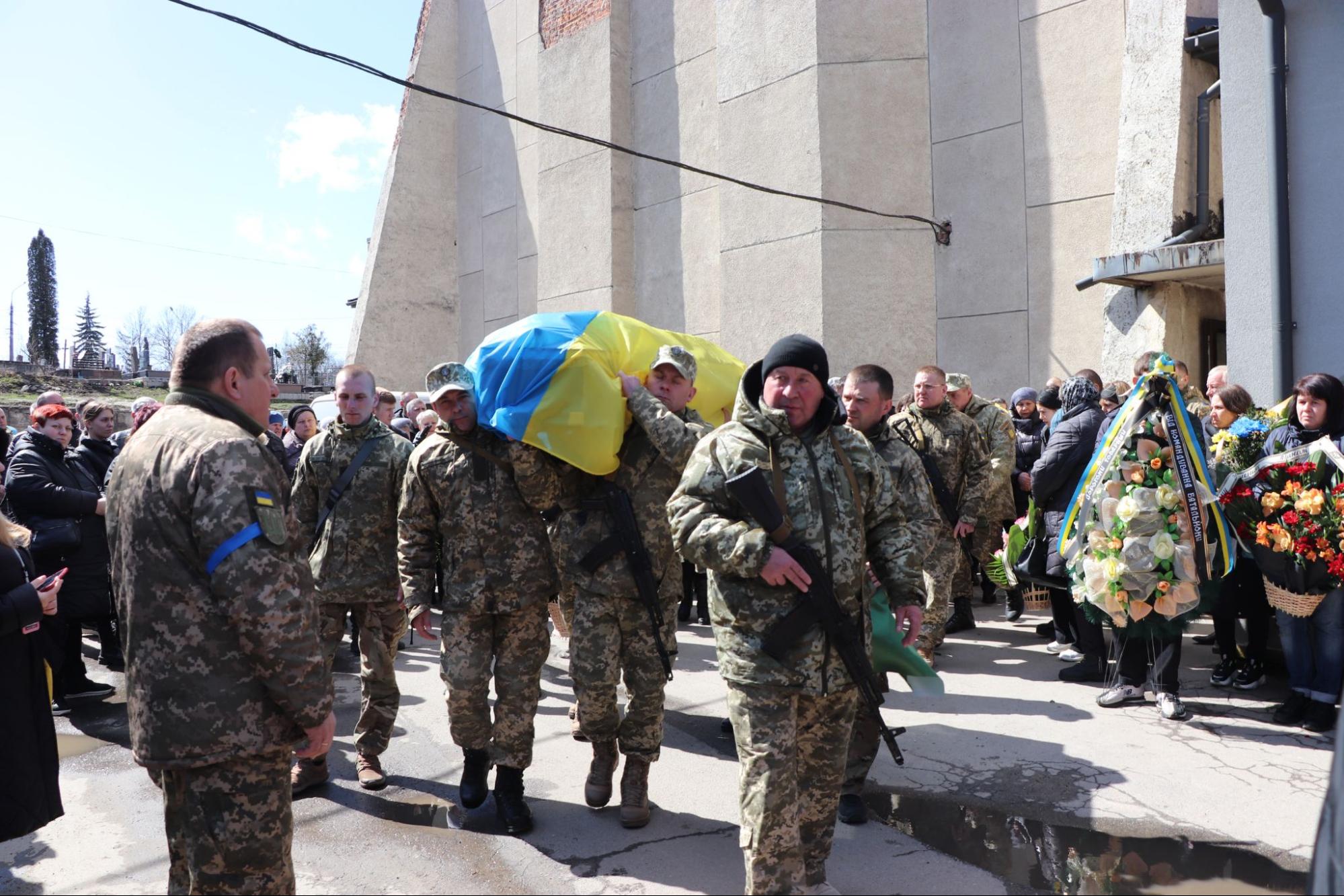
War Leads to Militarism
Funerals like Kuryk’s are now a regular feature of daily life all over Ukraine. At least 1,300 Ukrainian soldiers have died in the two-month-old war, according to the Ministry of Defense, but the actual number is understood to be much higher.
In addition, an unknown number of civilians have also been killed. This toll is a grim addition to the 13,000 people killed in 2014, when Russia annexed Crimea and when Russia-backed separatists launched a war in the eastern Donbas region, until the invasion began on February 24.
These losses, and nearly a decade of ongoing war, have profoundly shifted Ukrainian society, says Catherine Wanner, a professor of history and anthropology at Penn State University, who has published six books on the country. A “growing militarism” that arose during the 2014 conflict has “exponentially skyrocketed since the Russian invasion on February 24,” Wanner said.
“I remember in 2019, for example, seeing people wearing camouflage in the streets in western Ukraine. I had never seen anything like that before,” she added. “It has become sort of a normalization of the fact that the country is at war for years and years.”
Defined as the moment when military influence and priorities are extended to civilian life, militarization manifests when a society uses military solutions to solve problems, or when the military is a society’s most trusted institution. Evidence of both appears in Ukrainian society.
Whenever President Volodomyr Zelenskyy has appeared in public since the invasion, he is dressed in olive drab T-shirts, pullovers, and military fatigues. And after near-continuous dissatisfaction with inept or corrupt elected officials since the country gained independence following the first war with Russia, the two most trusted institutions in Ukraine have been the Orthodox Church and the army.
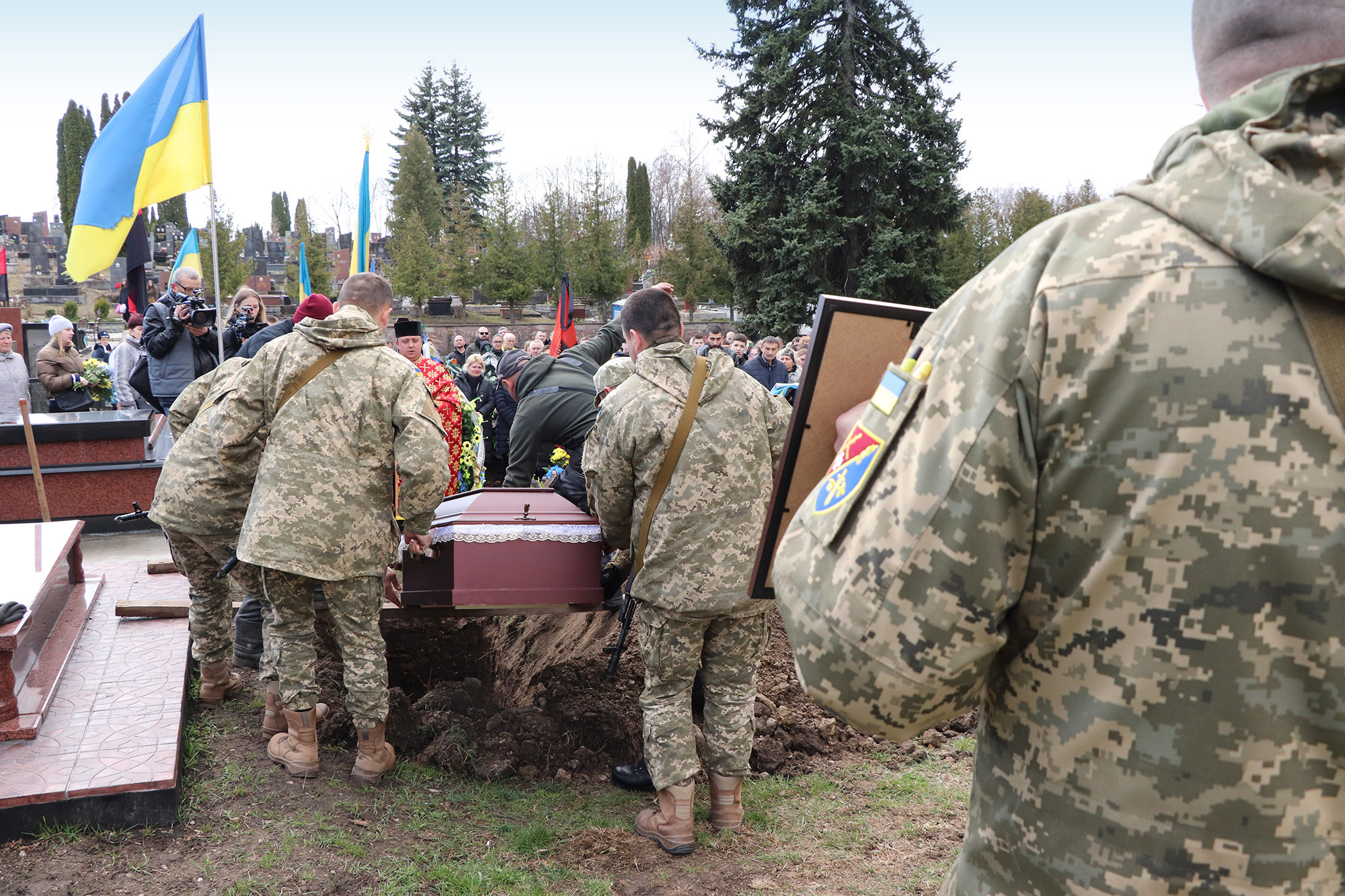
The “New Israel”?
In February, the Ukrainian Rating Sociological Group found that 75–78 percent of people in western and central Ukraine trusted the Ukrainian Armed Forces. In the eastern and southern regions, where Russian influence is more keenly felt, approval was only slightly lower: 64–66 percent.
Zelenskyy was not the first elected official to take notice. Many politicians in Ukraine have identified with the military since 2014 to brand themselves, according to Aleksey Jakubin, an associate professor at Kyiv Polytechnic Institute.
As it is the most trusted institution in Ukraine, the military has a significant influence on society beyond elected officials — an influence that’s growing at a faster pace since the Russian invasion.
“Some people write on social media that they believe in God and the military forces in Ukraine,” he said. “Like it is a religion.
“People first and foremost believe in the military now as the guarantee of Ukrainian independence. Before February, we discussed the military and its impact on society. That is gone.
“People are now talking about how we should become ‘the new Israel,’” he said, a reference Zelenskyy also used during an April 5 address, in which he foretold of a future Ukraine where armed soldiers in supermarkets and cinemas are a normal feature of daily life.
This vision of Ukraine is built on a foundational belief, reinforced during the past two months, “that only with a strong military will we survive,” Jakubin said. “That the army should be first and that the question of security is much more important than anything else.”
Like Israel’s, Ukraine’s militarism is, at least partially, a product of its battlefield successes. Israel defeated a coalition of Arab nations during the Six-Day War and the Yom Kippur War in the late 1960s and early 1970s. In 2014, militias defending eastern Ukraine from Russian invasion enjoyed some success. During the current war, instead of folding quickly, Ukraine’s army has punched far above its weight.
Whether Ukraine will mirror Israel — where men serve 32 months and women serve 24 months of compulsory military service and the government spends around 5.6 percent of gross domestic product on the military (which is higher than the 3.7 percent in the United States) — remains to be seen.
The Ukrainian army had around 200,000 active soldiers prior to the Russian invasion in February, and an estimated 900,000 in reserve, out of a total population of around 44 million, according to the World Bank. This ranks the Ukrainian military as the second largest army in Europe, only behind Russia.
Current Ukrainian law requires men to serve 12 to 18 months in the military, though others volunteer in units such as the volunteer battalions formed during the 2014 war, some of which were funded by oligarchs. These include the controversial Azov unit, formed around a cadre of far-right ultranationalists that critics, including Russia, say is neo-Nazi, but which has since been incorporated into the official Ukrainian military.
For the moment, all Ukrainian men aged 18 to 60 are forbidden from leaving the country, and instead must report to local recruitment offices — though only reservists have so far been compelled to join the regular army and other units at the frontlines. However, with the country handing out Kalashnikov assault rifles to nearly anyone who asks, in addition to the civilian-owned guns, as many as one in four Ukrainians are believed to have access to a firearm. This makes Ukraine one of the most heavily armed countries in the world.
Making Stuff for the Military
For now, potent reminders that Ukraine is at war are everywhere, even far from the frontline and away from weapons.
Checkpoints repeatedly interrupt life, even in relatively peaceful western Ukraine. Small villages have blocked entrances into town. Sandbags surround buildings, and people have crossed their windows with tape to prevent them from shattering.
Along with billboards featuring Kyruk, other martial ads are everywhere. A popular one says, “Русский военный корабль, иди на хуй,” or “Russian warship, go fuck yourself,” the notorious riposte to the since-sunken Moskva from the defenders of Snake Island. The man who said it, border guard Roman Hrybov, is now a national hero feted by Zelenskyy, his defiance memorialized in a wildly popular commemorative postage stamp.
Another Ukrainian manufacturer has also started making stuffed-toy versions of Bayraktar drones and Javelin anti-tank missiles.
The news on Ukrainian TV and social media is mainly about the war. At the beginning of the invasion, radio stations instructed people on how to make Molotov cocktails. Instead of beer, a Ukrainian brewery in Lviv switched to producing the homemade gasoline bombs, but under the label “Bandera Smoothie” — a reference to the Ukrainian nationalist Stepan Bandera, a controversial right-wing figure notorious for collaborating with Nazi Germany during World War II. Bandera’s influence over Ukrainian society is exaggerated by Vladimir Putin, who uses it as justification for the invasion, but Bandera is clearly not a national pariah.

For example, in Ternopil, a group of tourist guides and tech workers make belts, tourniquet bags, and magazine carriers for the army after collecting donations from locals and foreigners to buy raw materials.
“People were split before the Russian invasion, discussing if it would happen or not,” said 31-year-old Dima, who didn’t want to give his last name. “Now we don’t have that anymore. We are all working for the same thing after seeing what the Russians really are.”
“We are fighting for freedom — for our democracy,” said 28-year-old Sofia, who works in IT and has joined the tourist guides in helping the military. “To decide for ourselves what we want to do. So it is not only about us as a nation, but about our freedom.”
The Russian Example
Local elected officials embrace Ukraine’s new identity. Serhiy Nadal, the mayor of Ternopil, is proud of how the city and the whole country have come together to fight Russia. He points out that Ukraine has been fighting since 2014, but that the recent Russian invasion has united the people like never before.
“Now we don’t have any politics. Now all people are together with one goal,” Nadal said. “We are together fighting against our common enemy. … And our children or grandchildren will not forgive what happened, and they [Russia] will have to pay for this, like Germany is paying for the Jews, asking for forgiveness all the time.”
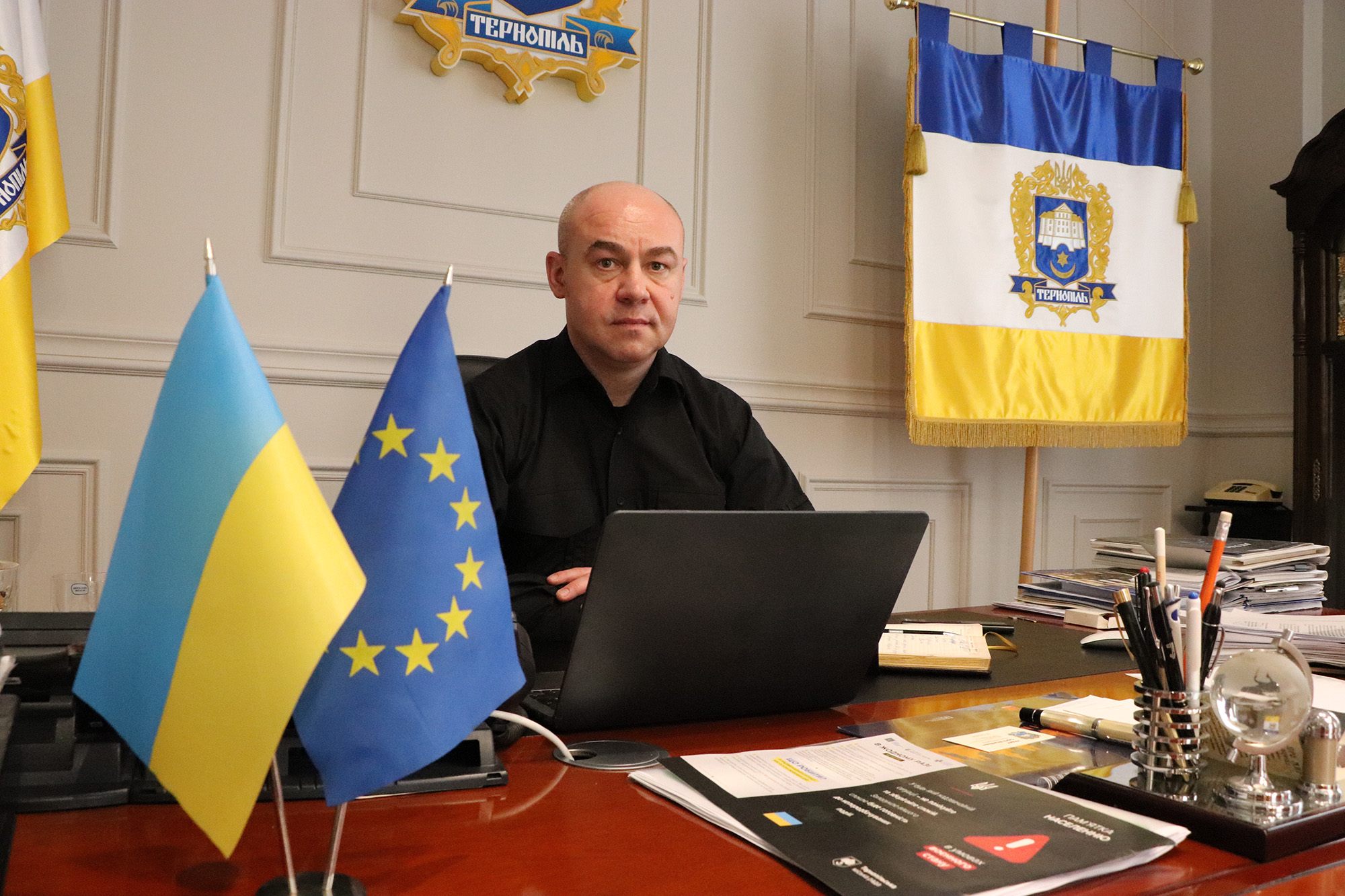
While militarization is useful for mobilizing a society against an enemy, it has repercussions that can be long-lasting and dangerous.
In Russia, for example, militarization has desensitized citizens to violence. Children attend military summer camps and can be seen marching in military uniforms, says Eugene Miakinkov, a professor at Swansea University in the United Kingdom and an expert on war and society with a particular focus on Russia.
“You have these tiny little Russians in uniforms, pledging allegiance to defend Russia,” he said. “These four-year-old kids, who should be counting Oreos in the lunchbox, are in a very insidious way introduced through games and cool tanks and equipment and camps and history and various activities to what essentially amounts to sort of premilitary training.”
That kind of militarism is dangerous for society because it merges the idea of patriotism and militarism together to favor military solutions to problems — even in civilian life when it comes to such things as police work and education, he said. It’s too soon to tell whether Zelenskyy’s vision will come to pass, but Ukrainian society should be cautious, he said, as militarism isn’t something that can be easily halted or reversed once begun.
It Can Be Hard to Demilitarize
Militarism often promotes traditional gender norms, said Wanner, adding that “one of the biggest challenges for Ukraine” after the war “will be to relax and roll back that kind of militarized preparedness.”
The United States also offers a warning about how martial institutions are tough to later disempower or retire. During his famous 1961 farewell address, President Dwight D. Eisenhower warned about the encroaching influence on society of the “military-industrial complex,” a cabal of business and the armed forces that dictated policy as well as armed the country — an ironic cautionary message, since Eisenhower was a product of that same mentality, using his cachet as the victorious top Allied general who defeated the Nazis in Europe to become president.
“The potential for the disastrous rise of misplaced power exists and will persist,” Eisenhower said. “We must never let the weight of this combination endanger our liberties or democratic processes.” More than 60 years later, with the US still the world’s largest military — the US Navy operates 11 nuclear-powered aircraft carriers; its closest rivals, Russia and China, operate a total of three between them — Eisenhower’s warning is understood to have gone unheeded.
The US’s experience in the global war on terror, which created a public health crisis leaving hundreds of thousands of ex-servicepeople with post-traumatic stress disorder, offers another warning. It can be challenging for soldiers who have been in a hierarchic institution such as the military “to reintegrate back into civilian societies and go back to their families and their normal jobs,” Miakinkov said.
They might take their military mindset, in which decisions are made in an undemocratic, top-down fashion, to their jobs as school principals, managers, and politicians, ensuring the cycle self-perpetuates over generations, he said.
Once militarized, a society may never un-militarize.

Oh, What a Wonderful War
To some extent, Ukraine’s hyper-militarization was an inevitable result of the invasion. The invasion means it will also be very hard to reverse.
“People will take it with them to their jobs after the war, and the war will become their frame of reference because it’s such a momentous occasion,” Miakinkov said.
“War is one of the most horrible and tragic, but also the most momentous occasions in people’s lives like weddings or birth of children. These are some of the most powerful experiences people ever go through. So they will use this as a reference later in life and influence how we act.
“The question is about how to reverse militarization, and that is not something that I have an answer to, unfortunately,” he added, noting that demilitarization cannot simply happen with a few new laws, as pressure to continue will also come from society bottom-up.
Jakubin fears that the military will retain a considerable influence over Ukrainian society after the war.
“After the war, the military influence in Ukraine will be much higher than before,” he said. “Maybe it could transform the military from a service to a real political influence like in some Latin American countries.”
“”But now is not a determining process yet; much will depend on the actions of the Ukrainian authorities — the next steps of President Zelenskyy,” he said. “Including the issue of establishing effective civilian control over the army.”
Icons on the Wall
Ukrainians who lost family members are a part of this new culture. Standing over her dead son’s grave, Mykola Kuryk’s mother says she doesn’t regret anything. On the contrary, Sofia Kuryk is proud of her son’s sacrifice.
Mykola was the second of her four children. He was the only one who signed up for the military. She finds peace in the fact that her son fought for his country.
A photo of her son now stands on the bookcase in the living room. Religious symbols surround it, another icon on the altar. But other imagery played a role; even before he signed up, Mykola had military images inscribed on his body — a Ukrainian symbol tattooed on his chest and a machine gun on his neck.
“We would not do anything differently because it cannot be different,” she says. “We love our country the same way we love our children. It’s the same. I love my Ukraine as much as I love Mykola. Russia has been killing us for hundreds of years.
“My kids are different, and Mykola would fight. He could not just hide. He could not find a reason not to. I do not judge those who flee, but I am proud that my son tried to defend Ukraine and the many dead women and children.”
